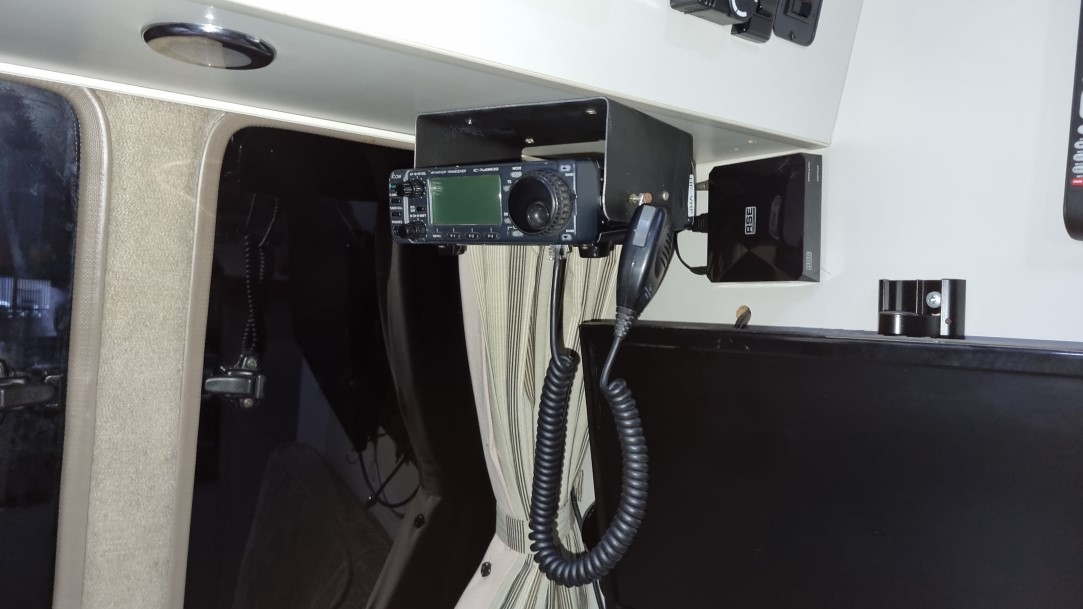
H.F Antenna Installation in an Recreational Vehicle
M.A.Pinfold, ZL1BTB
I have always wanted to work HF from remote installation .The mere fact of getting away from large amounts of “domestically generated noise” such a s computers, wireless modems , switch mode power supplies ,Television ,the list goes on and in our cities and towns, there is lots of it . All contributing to raising the local H.F. noise floor, often for some folk making H.F working almost impossible . I don't have HF at home for these reasons ,and lack of antenna space !.The idea is to remove onesself from as much as it as possible and take as little of it with you as you can ( a topic for another discussion at a later date )The purchase of a camper , a 7 m Toyota coaster was the impetus to make R.V HF a reality . I decided for safety reasons not to have the ham radio gear accessible when actually driving the camper as the distraction of the radio will comprimise our safety on the road . So the icom706 Mk2 G was mounted above the TV in the middle of the camper .

This leaves the
only option for H.F operation when we are parked up . This has a distinct
advantage as now you are not limited to a small mobile HF antenna . I remember
our first trip where I trialled HF using a wire dipole draped around the fence
and a tree we were parked up against in the camping ground. I used a little
yeasu FT817 and a manual tuner ..it sort of worked but was “messy installation”
and I thought “ there has to be a better way “!. I was somewhat mindful of extra
wires around in the busy campsite ,and Kids and dogs etc tangling and fiddling
with the antenna .Also the hassle involved , you have to ask for permission, in
actually setting the dipole up as well .need some sort of support then , tie
things up etc etc so I thought the easiest way is a vertical antenna , yes a big
one !
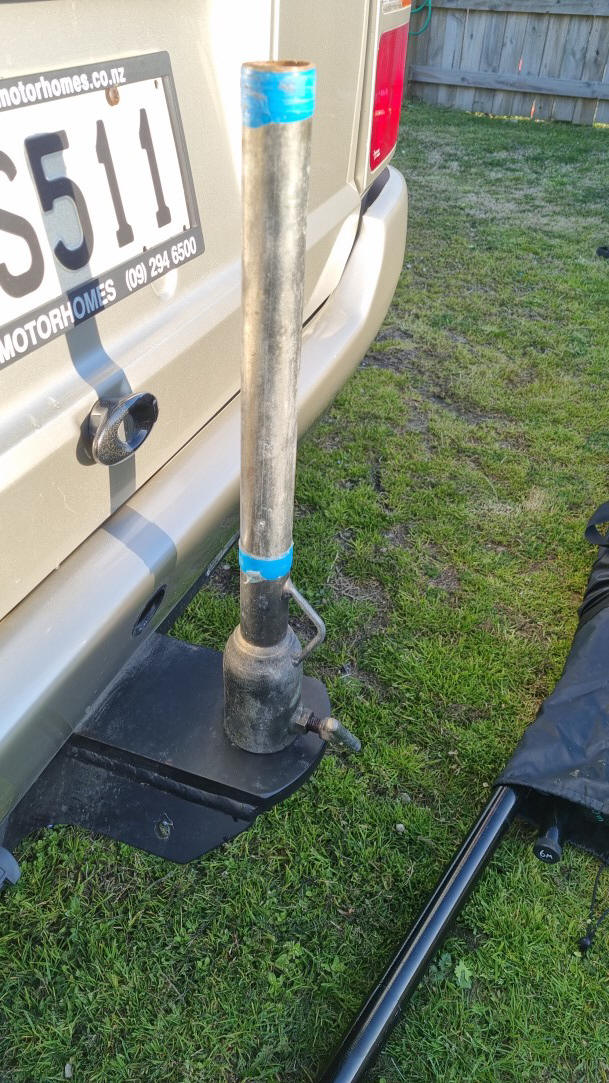
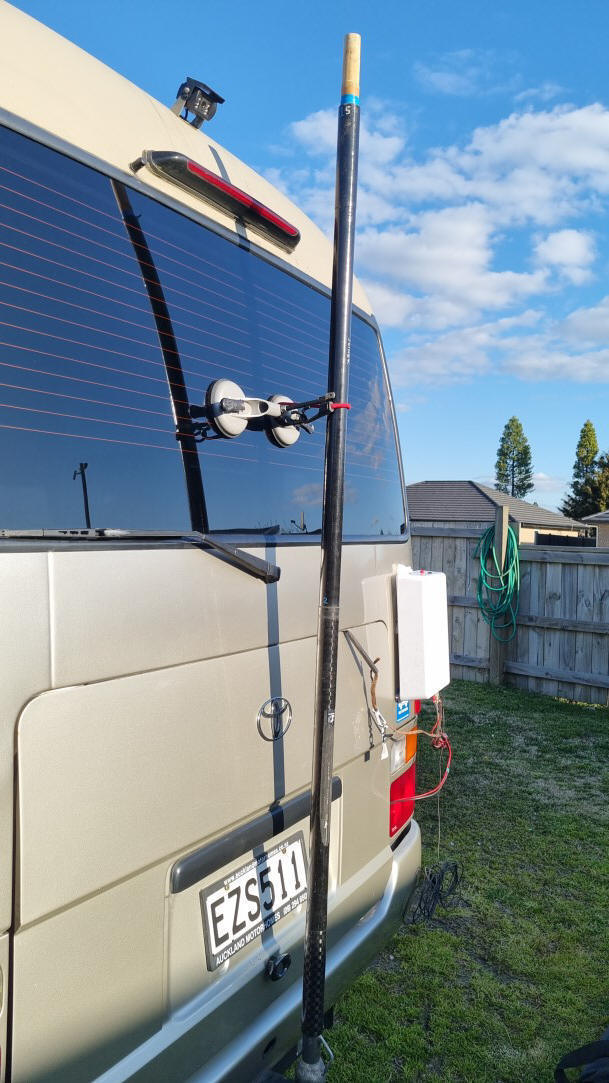
cut down bicycle carrier fibreglass extension poles to hold squid pole
And since I favour the low frequency bands from 160m and up eg 80.40.20m its got to be long to work well. ,I bought an extendable telescoping support from a fellow Ham ZL1TAJ ,it was called a “squid pole” This version was very robust ,lightweight , extended to 6m and telescoped down to about a meter in length and the base was about ( Xx mm internal dia) turned a wooden jointing dowel about 20 cm long so it could connect with my interlocking fibreglass masts , the squidy was remarkably robust for its “fibreglass type” of construction . To lock it, extend and put pulled the tapers tight. I also purchased several metre lengths of robustly constructed fibreglass tube ( diameter) with had male and female connections at each end purchased from Kilwell fibreglass factory in Rotorua, which enabled me to make a plug together a several meter long support pole to mount the extended telescopic squid pole on .
I decided the most
robust and secure part of the bus was the tow ball. And by judicious
modification to a simple bicycle rack with a hacksaw, the interlocking tubes
would slide over the cut down bike rack that would be screwed tightly over the
tow ball . Now I have a stable vertical support of what ever length I like
depending on how many interlocking sections I use to support the squid pole. ( I
used typically 4-5 metre extension) I figured Ill just attach the similar length
of wire to the top and wind it a few turns around the pole to hold the wire in
position, then plug it into the antenna tuner at the base of the pole. Because
my radio is inside the bus I don't use a manual tuner, Note: its not the best
practice to try and match the antenna through a run of coax, You will get signal
through the feed line but with high vswr your coax losses are going to reduce
the radiated and received signals . You really have to match to the antenna at
the base of the antenna for best radiated power . I did have an old SGC sg 630
auto antenna tuner which I wanted to use for frequency agility ( all bands) and
to mount this at the base of the antenna. I used a large old ferrite torroidal
magnetic antenna base attached by screws to the back of the auto tuner box , The
magnet is of sufficent strength to hold the Auto tuner to the metal of the
vehicle ( suction cups if your vehicle in fibreglass ???)
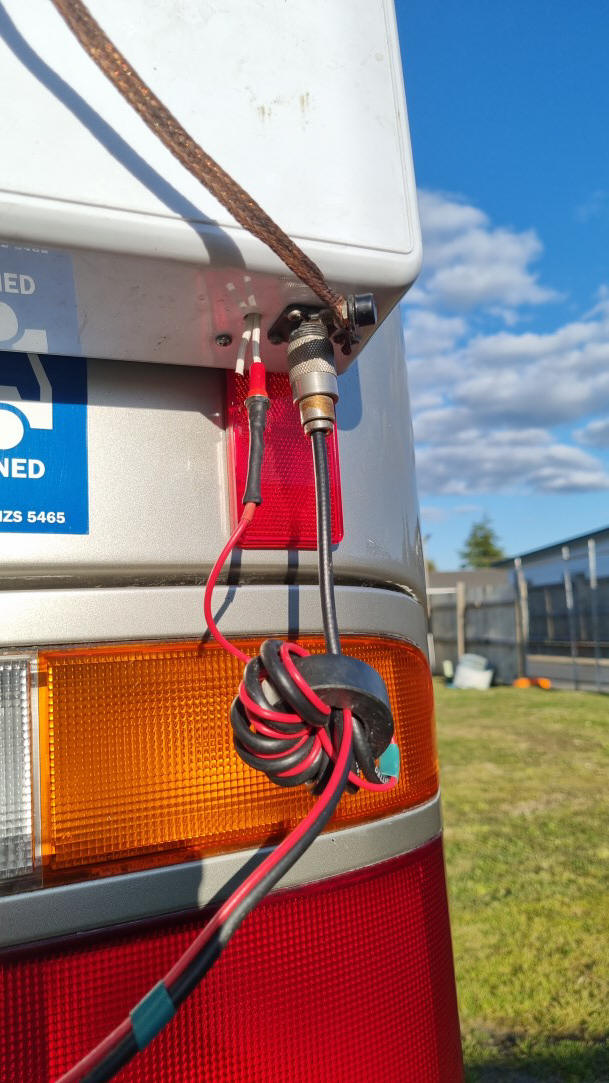
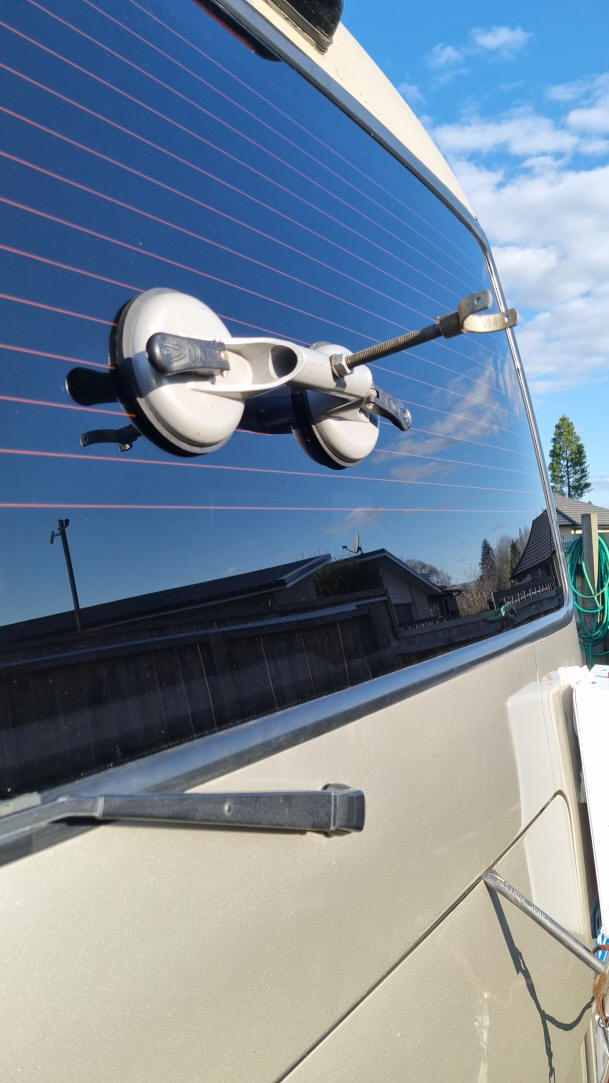
Coax ferrite choke and 12v connection glazier suction cup handle with support yoke
Place paper between
the magnet and the bodywork paint or mounting it will scratch your paint surface
.
The tuner has an extra braided copper earth strap connected to the “earth”
inside the tuner so I have the option of running out counterpoise wires if
convenient and this will improve your antenna performance . I also connect the
tuner earth to an earth strap connected to the bus body . The sgc630 auto tuner
runs of 12v dc at a few hundred mA so I connect a wire from the tuner that runs
back with the feed coax to attach to the tuner accessory socket on the back of
the “706, that has +12v supply when the radio is turned on. At this stage I have
not run a “tuner lock” control wire from the auto tuner to the radio. I have a
“random wire “ with a loading coil 2/3 of the way up the antenna wire the
loading coil is random no. of turns (~20 ) wound on a thin walled plastic former
100 mm in dia ,hopefully to push more rf current up the lower 2/3 of the
antenna. The antenna wire is attached to a small curtain wire loop screwed
into the rubber cap on the top of the squid pole it wraps around the antenna
support and is terminated with a banana plug that inserts to a matching banana
socket in the top of the sg630 tuner box and connected inside to the ant
connection ( not my box is not a real sg630 tuner box but one from Kmart
that the pcboard fits inside perfectly. The Auto tuner will sort the RF
match. As the antenna is used for multi frequency and because the antenna is
shorter than a quarter wavelength, the loading coil should help radiation
efficiency.There is no reason why you could not use this antenna as a centre
support for a lightwieght inverted ”V” antenna (G5RV?) if you were out in the
boondocks alone . where there was no one to tangle in the ends of your antenna
.A dipole would be an even better more efficient antenna to use .
I have noted that
with my coax not connected to the antenna tuner and I tune around , I can pick
up some noise generated within the vehicle wiring I suspect the coax is picking
stuff up because in some places it runs next to toyota wires ! Although my RG58
is of a tight weave braid it is still leaky ,the 706 is a sensitive radio so I
may change to well screened double braided coax which is even less leaky and see
if that helps, whether it makes any practical operating difference is debatable.
To add additional stability to the vertical support tube I used a suggestion a fellow ham ZL2QX uses to hold his antenna to his fibreglass camper those “two suction cup” handles that glaziers use to hold glass with ,I attached mine to the rear window of the bus .It has a small mounting support I made to cradle the mast and a small bungee holds the support pole tight to the suction cup,.
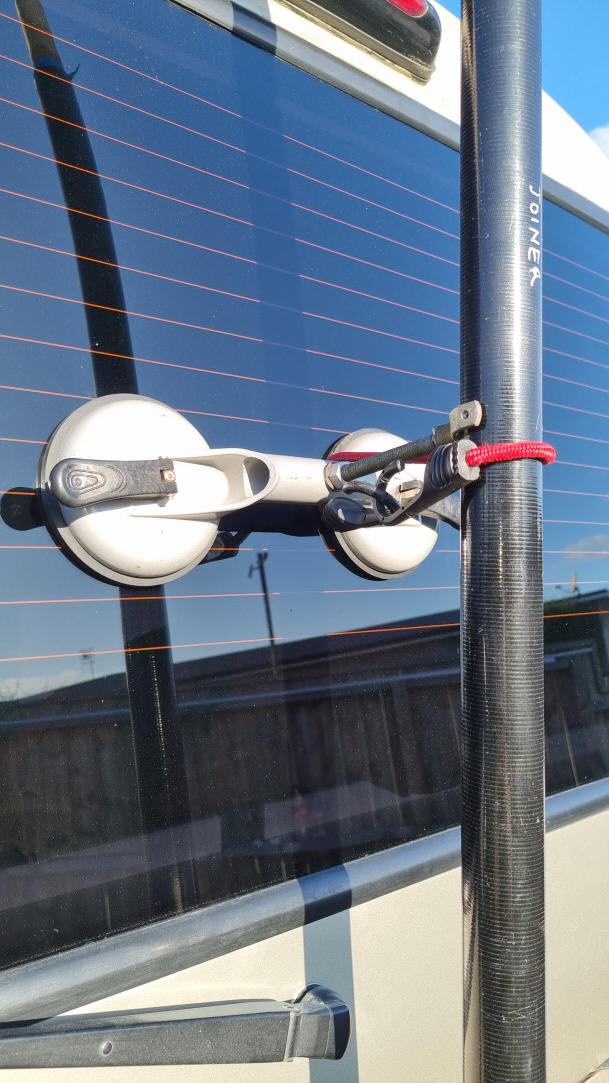
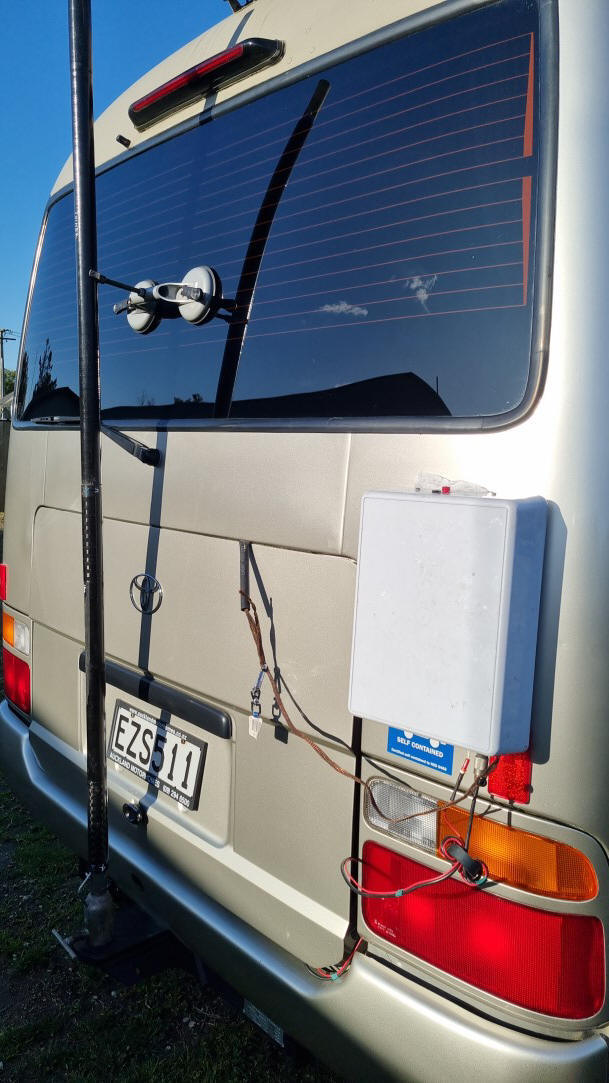
Additional support via rear window Basic configuration in use
The squid pole on its own could be used as it is remarkably light weight to pick
up and stand vertically and even with the 5 m extension its still manageable for
a 67 yr old!!
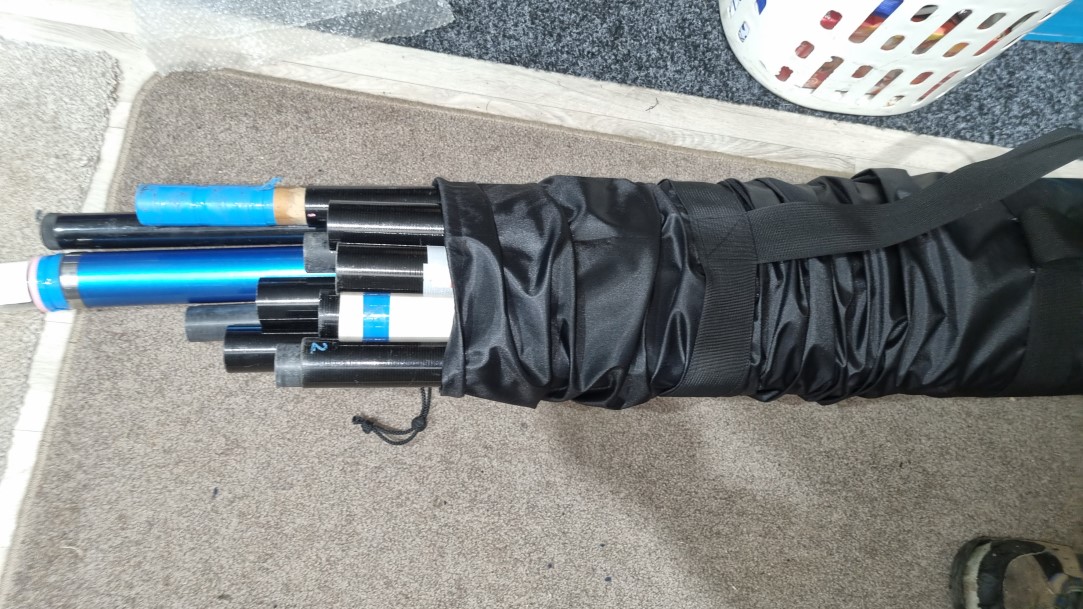
Interlocking extension poles from Kilwell
Rotorua to go to as high as you dare
I keep the extension poles and the two squid poles (a 6m and a 10m) in a bag similar to a folding camp chair bag ,in the boot of the bus , it only takes 5 minutes to erect and get operational .The use of an auto tuner ( optional) makes things so easy ,one could use a manual match network at the base but that will restrict frequency excursions ,the choice is yours .
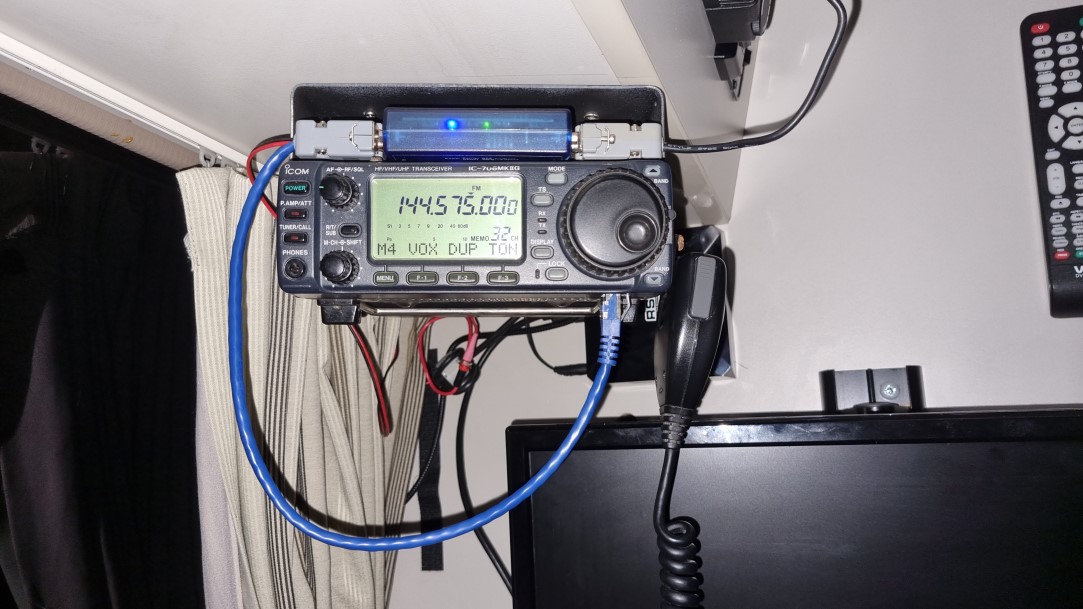
End result with additional dual band VHF UHF antenna / gps on roof for mobile APRS using Byonics TT4 (Zl1btb-12 )
How does it go ? Well I have had a lot of fun with only 100W of RF , the
vertical is more for DX than local nz chats and Im sure a dipole will be better
for “local” rag chewing up and down ZL and if your campsite has space that would
be a better option . do put out radials if you can ,Suffice to say that many
times freedom camping at the seaside I have been responible for many satisfied
European hams wishing to contact down under and regularly get “trapped” on a 40m
Frequency to work them waiting in line
I tend to operate in the evening as my own mppt solar equipment will stop
generating rf noise when the sun goes down however close RV's
will potentially cause RFI. so I try and camp solo
.
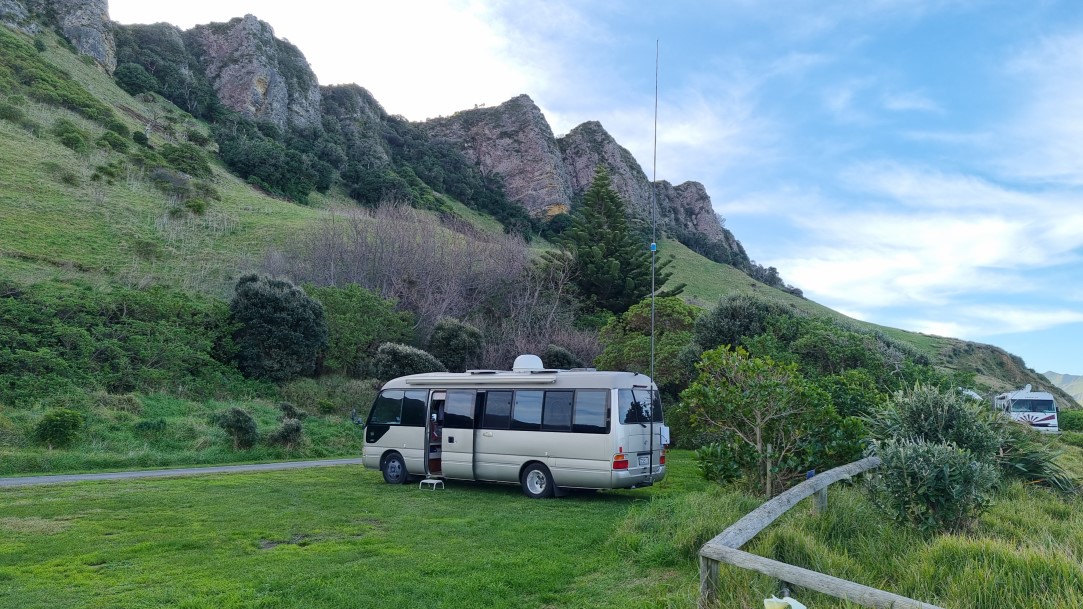
Finished result with antenna at about 9
m though with a longer wire and more base sections I can go up much
higher
surprisingly the 6m squid pole has much much less wind
resistance than the thicker 10 m squid pole has
Try it im sure you will like it cheers Mike Pinfold ZL1BTB